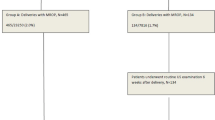Abstract
Purpose
Retained products of conception (RPOC) may occur as the result of a morbidly adherent placenta. In these cases, the hysteroscopic removal of RPOC may be technically challenging, and may require more than one hysteroscopic procedure. We sought to compare the clinical, surgical, and postoperative characteristics of cases managed by either a one-step hysteroscopy procedure or a two-step hysteroscopy approach.
Methods
A retrospective review of all RPOC cases managed by hysteroscopy from 1/2013 to 3/2018. We included cases of RPOC occurring following delivery and medical or surgical pregnancy terminations. The rates of postoperative intrauterine adhesions were assessed by office hysteroscopy.
Results
A two-step procedure was required in 11 (3.9%) of the 358 women who underwent hysteroscopy for removal of RPOC during the study period. Comparison between the two-step and the one-step procedure groups revealed that the women in the two-step group were significantly older and the mean RPOC size was significantly larger (35.5 ± 4.1 years versus 30.7 ± 5.9 years, respectively, p = 0.01, and 38.6 ± 9.8 mm versus 22.3 ± 7.5 mm, p < 0.001, respectively). While the rates of intraoperative complications were similar between groups, readmission for postoperative fever was more common in the two-step group (18.2% versus 2.0%, respectively, p = 0.03). Postoperative intrauterine adhesions were diagnosed in 20.0% and 5.2%, respectively (p = 0.05).
Conclusions
The two-step hysteroscopic approach enabled the complete removal of larger RPOC masses without the use of uterine curettage. The women who underwent the two-step procedure, however, were at increased risk for postoperative fever and postoperative intrauterine adhesions.



Similar content being viewed by others
References
van den Bosch T, Daemen A, Van Schoubroeck D, Pochet N, De Moor B, Timmerman D (2008) Occurrence and outcome of residual trophoblastic tissue: a prospective study. J Ultrasound Med. 27:357–361
Hooker AB, Aydin H, Brölmann HA, Huirne JA (2016) Long-term complications and reproductive outcome after the management of retained products of conception: a systematic review. Fertil Steril. 105:156–164
Smorgick N, Mittler A, Ben-Ami I, Maymon R, Vaknin Z, Pansky M (2018) Retained products of conception: What is the risk for recurrence on subsequent pregnancies? Eur J Obstet Gynecol Reprod Biol. 224:1–5
Ikhena DE, Bortoletto P, Lawson AK, Confino R, Marsh EE, Milad MP, Steinberg ML, Confino E, Pavone ME (2016) Reproductive outcomes after hysteroscopic resection of retained products of conception. J Minim Invasive Gynecol. 23:1070–1074
Fox KA, Shamshirsaz AA, Carusi D, Secord AA, Lee P, Turan OM, Huls C, Abuhamad A, Simhan H, Barton J, Wright J, Silver R, Belfort MA (2015) Conservative management of morbidly adherent placenta: expert review. Am J Obstet Gynecol. 213:755–760
Legendre G, Zoulovits FJ, Kinn J, Senthiles L, Fernandez H (2014) Conservative management of placenta accreta: hysteroscopic resection of retained tissues. J Minim Invasive Gynecol. 21:910–913
Capmas P, Levaillant JM, Fernandez H (2013) Surgical techniques and outcome in the management of submucous fibroids. Curr Opin Obstet Gynecol. 25:332–338
Hrazdirová L, Kuzel D, Zizka Z (2012) Is the hysteroscopy the right choice for therapy of placental remnants? Ceska Gynekol. 77:35–38
Smorgick N, Barel O, Fuchs N, Ben-Ami I, Pansky M, Vaknin Z (2014) Hysteroscopic management of retained products of conception: meta-analysis and literature review. Eur J Obstet Gynecol Reprod Biol. 173:19–22
The American Fertility Society classifications of adnexal adhesions (1998) Distal tubal occlusion, tubal occlusion secondary to tubal ligation, tubal pregnancies, mullerian anomalies and intrauterine adhesions. Fertil Steril. 49:944–955
Wong AS, Cheung CW, Yeung SW, Fan HL, Leung TY, Sahota DS (2014) Transcervical intralesional vasopressin injection compared with placebo in hysteroscopic myomectomy: a randomized controlled trial. Obstet Gynecol. 124:897–903
Kamaya A, Petrovitch I, Chen B, Frederick CE, Jeffrey RB (2009) Retained products of conception: spectrum of color Doppler findings. J Ultrasound Med. 28:1031–1041
Hamerlynck TW, van Vliet HA, Beerens AS, Weyers S, Schoot BC (2016) Hysteroscopic morcellation versus loop resection for removal of placental remnants: a randomized trial. J Minim Invasive Gynecol. 23:1172–1180
Author information
Authors and Affiliations
Contributions
We confirm that each author has fulfilled the conditions of having made substantial contributions to the concept and design, analysis, and interpretation of data and drafting and/or revisions of the manuscript. None of the authors have any disclosures.
Corresponding author
Ethics declarations
Conflict of interest
The authors have no conflicts of interest to disclose.
Additional information
Publisher's Note
Springer Nature remains neutral with regard to jurisdictional claims in published maps and institutional affiliations.
Rights and permissions
About this article
Cite this article
Smorgick, N., Rabinovitch, I., Levinsohn-Tavor, O. et al. Two-step hysteroscopy for management of morbidly adherent retained products of conception. Arch Gynecol Obstet 300, 669–674 (2019). https://doi.org/10.1007/s00404-019-05246-1
Received:
Accepted:
Published:
Issue Date:
DOI: https://doi.org/10.1007/s00404-019-05246-1




